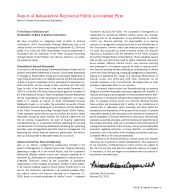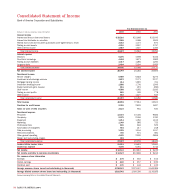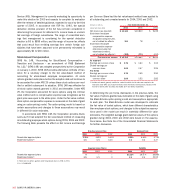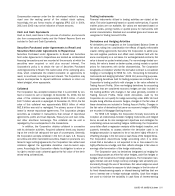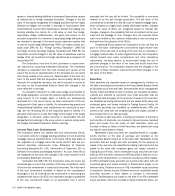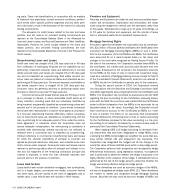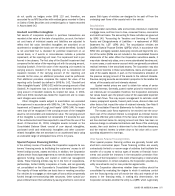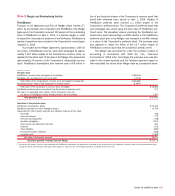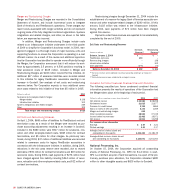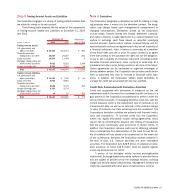Bank of America 2004 Annual Report Download - page 104
Download and view the complete annual report
Please find page 104 of the 2004 Bank of America annual report below. You can navigate through the pages in the report by either clicking on the pages listed below, or by using the keyword search tool below to find specific information within the annual report.
Compensation expense under the fair value-based method is recog-
nized over the vesting period of the related stock options.
Accordingly, the pro forma results of applying SFAS 123 in 2004,
2003 and 2002 may not be indicative of future amounts.
Cash and Cash Equivalents
Cash on hand, cash items in the process of collection, and amounts
due from correspondent banks and the Federal Reserve Bank are
included in Cash and Cash Equivalents.
Securities Purchased under Agreements to Resell and
Securities Sold under Agreements to Repurchase
Securities Purchased under Agreements to Resell and Securities
Sold under Agreements to Repurchase are treated as collateralized
financing transactions and are recorded at the amounts at which the
securities were acquired or sold plus accrued interest. The
Corporation’s policy is to obtain the use of Securities Purchased
under Agreements to Resell. The market value of the underlying secu-
rities, which collateralize the related receivable on agreements to
resell, is monitored, including accrued interest. The Corporation may
require counterparties to deposit additional collateral or return col-
lateral pledged, when appropriate.
Collateral
The Corporation has accepted collateral that it is permitted by con-
tract or custom to sell or repledge. At December 31, 2004, the fair
value of this collateral was approximately $152.5 billion of which
$117.5 billion was sold or repledged. At December 31, 2003, the fair
value of this collateral was approximately $86.9 billion of which
$62.8 billion was sold or repledged. The primary source of this col-
lateral is reverse repurchase agreements. The Corporation pledges
securities as collateral in transactions that consist of repurchase
agreements, public and trust deposits, Treasury tax and loan notes,
and other short-term borrowings. This collateral can be sold or
repledged by the counterparties to the transactions.
In addition, the Corporation obtains collateral in connection
with its derivative activities. Required collateral levels vary depend-
ing on the credit risk rating and the type of counterparty. Generally,
the Corporation accepts collateral in the form of cash, U.S. Treasury
securities and other marketable securities. Based on provisions con-
tained in legal netting agreements, the Corporation has netted cash
collateral against the applicable derivative mark-to-market expo-
sures. Accordingly, the Corporation offsets its obligation to return or
its right to reclaim cash collateral against the fair value of the deriv-
atives being collateralized.
Trading Instruments
Financial instruments utilized in trading activities are stated at fair
value. Fair value is generally based on quoted market prices. If quoted
market prices are not available, fair values are estimated based on
dealer quotes, pricing models or quoted prices for instruments with
similar characteristics. Realized and unrealized gains and losses are
recognized in Trading Account Profits.
Derivatives and Hedging Activities
All derivatives are recognized on the Consolidated Balance Sheet at
fair value, taking into consideration the effects of legally enforceable
master netting agreements that allow the Corporation to settle posi-
tive and negative positions and offset cash collateral held with the
same counterparty on a net basis. For exchange-traded contracts, fair
value is based on quoted market prices. For non-exchange traded con-
tracts, fair value is based on dealer quotes, pricing models or quoted
prices for instruments with similar characteristics. The Corporation
designates at inception whether the derivative contract is considered
hedging or non-hedging for SFAS No. 133, “Accounting for Derivative
Instruments and Hedging Activities” (SFAS 133) accounting purposes.
Non-hedging derivatives held for trading purposes are included in the
Corporation’s trading portfolio with changes in fair value reflected in
Trading Account Profits. Other non-hedging derivatives for accounting
purposes that are considered economic hedges are also included in
the trading portfolio with changes in fair value generally recorded in
Trading Account Profits. Most credit derivatives used by the
Corporation do not qualify for hedge accounting under SFAS 133 and
despite being effective economic hedges, changes in the fair value of
these derivatives are included in Trading Account Profits. Changes in
the fair value of derivatives that serve as economic hedges of MSRs
are recorded in Mortgage Banking Income.
For SFAS 133 hedges, the Corporation formally documents at
inception all relationships between hedging instruments and hedged
items, as well as its risk management objectives and strategies for
undertaking various accounting hedges. Additionally, the Corporation
uses dollar offset or regression analysis at the hedge’s inception, and
quarterly thereafter, to assess whether the derivative used in its
hedging transaction is expected to be or has been highly effective in
offsetting changes in the fair value or cash flows of the hedged items.
The Corporation discontinues hedge accounting when it is deter-
mined that a derivative is not expected to be or has ceased to be
highly effective as a hedge, and then reflects changes in fair value in
earnings after termination of the hedge relationship.
The Corporation uses its derivatives designated as hedging for
accounting purposes as either fair value hedges, cash flow hedges or
hedges of net investments in foreign operations. The Corporation man-
ages interest rate and foreign currency exchange rate sensitivity pre-
dominantly through the use of derivatives. Fair value hedges are used
to limit the Corporation’s exposure to total changes in the fair value of
its fixed interest-earning assets or interest-bearing liabilities that are
due to interest rate or foreign exchange volatility. Cash flow hedges
are used to minimize the variability in cash flows of interest-earning
BANK OF AMERICA 2004 103




